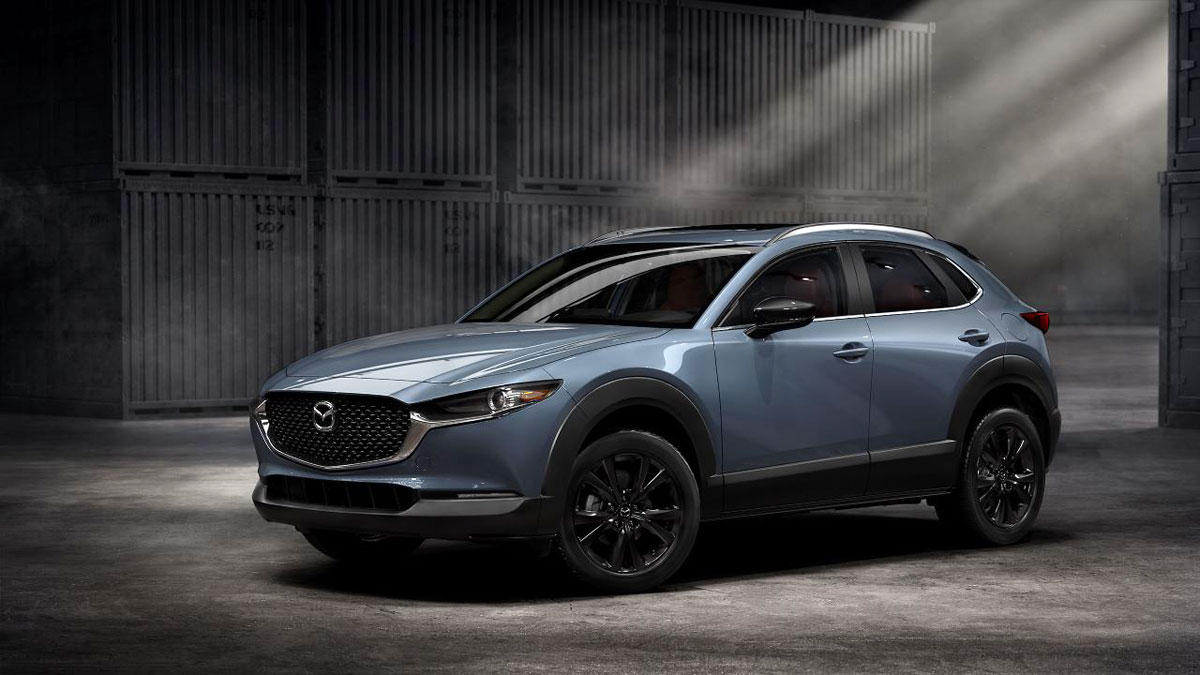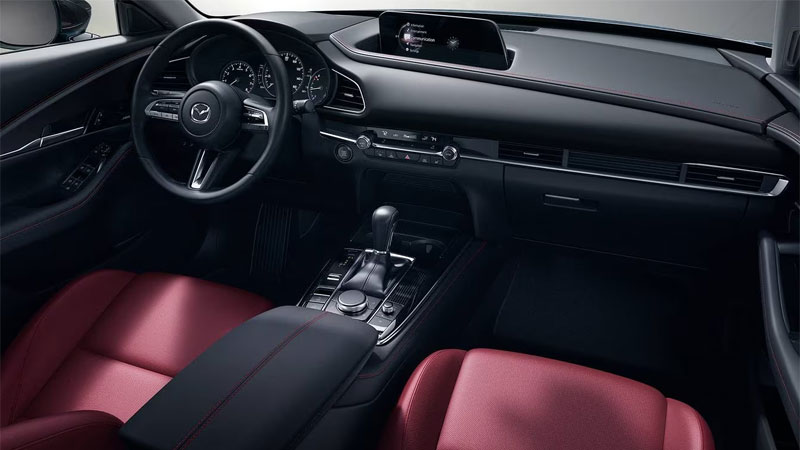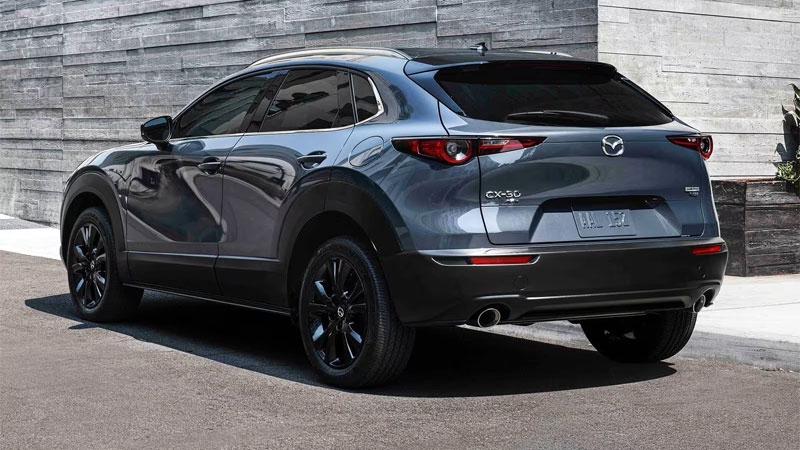The CX-30 blurs the line between a hatchback and a utility vehicle, sparking curiosity among observers.
The compact Mazda CX-30, built on the same platform as the Mazda3 car, is technically a crossover SUV. However, its elevated stance is the only major distinction from a hatchback.
This deliberate design choice highlights the CX-30’s unique blend of style and driving enjoyment, positioning it as a versatile and attractive option in the small SUV category.
2024 Mazda CX-30 Review
Mazda offers the 2024 CX-30 in eight grades, including three that are turbo-powered.
- The 2.5 S costs $24,995, followed by the 2.5 S Sport Select ($26,500), 2.5 S Preferred ($28,790), 2.5 S Carbon Edition ($29,970), and 2.5 S Premium ($31,990).
- The three turbo models include the 2.5 Carbon Turbo ($32,790), 2.5 Turbo Premium ($34,990), and 2.5 Turbo Premium Plus ($36,800). Add $1,375 for the delivery charge.
The CX-30 seats five and comes with standard all-wheel drive and an automatic transmission. For 2024, the Carbon Turbo trim is new. Also, blind-spot monitoring and rear-cross traffic alert are now standard across the model range.
See Also – 2023 Mazda CX-30 Review
Exterior Highlights
The Mazda CX-30 stands out in its ability to closely resemble a hatchback, more so than many other SUVs. This similarity is by design, as the CX-30 borrows the bold front end and sleek styling cues from the Mazda3 hatchback and sedan, its foundational model.
Apart from its heightened stance, the CX-30 shares numerous design elements with a hatchback. The most prominent difference is its tapered rear end, distinguishing it within the SUV category while maintaining a hatchback-like appeal.
Aluminum-alloy wheels come standard, signifying this model’s premium vibe in a highly competitive segment. Roof rails and roof rail crossbars are included on all but the base trim, with custom LED front and rear lighting reserved for the top trim.
A matte finish black grille is standard; a gloss-black grille is available. Mazda makes available a power liftgate on the upper trims.
Interior Highlights
On paper, the CX-30 seats five, but this model is ideal for two. The rear seat is very tight for adults, although two can sit for short trips. Three is a squeeze and an unpleasant one at that.
The rear seat doesn’t fold completely flat, offering 45.2 cubic feet of cargo capacity. Still, that’s about two-thirds the capacity of the Volkswagen Taos, one of the roomiest compact SUVs on the market.
The CX-30’s interior offers clean lines and easy-to-reach controls. Move up through the trim range and the luxury vibe stands front and center with a leather-wrapped dashboard, heated power-controlled front seats, and an available heated steering wheel. Absent from the mix are ventilated front seats.
The front seats in the Mazda CX-30 are comfortable and provide ample support for the back, hips, and sides. Despite being a top-trim model, our test vehicle did not include a seat extender, a feature often found in luxury vehicles and seemingly suitable for this model.
Standard features include full power controls, with most models also offering dual-zone climate control and ambient lighting.
See Also – Reviewed: 2024 Mazda CX-5
Technology and Safety
Mazda offers a mixed bag of technologies, beginning with its 8.8-inch screen, controlled by a center knob. Some models offer a 10.25-inch screen that converts to a touchscreen with Apple CarPlay or Android Auto. Even with touchscreen access, the interface sits further back on the dashboard than we like, making it difficult for short people to reach.
On the other hand, the CX-30 comes with a standard 8-speaker audio package with HD Radio. It offers a strong level of sound clarity from the start and is bundled with a Wi-Fi hotspot, Bluetooth, and smartphone connectivity. Satellite radio, though, is bundled with the available 12-speaker Bose audio package and a wireless charging pad.
On the safety front, this Mazda comes with such features as forward collision warning, automatic emergency braking, lane control, adaptive cruise control, and automatic high-beam headlights.
Some trims offer adaptive headlights, a head-up display, and a surround-view camera system. Front and rear parking sensors and reverse automatic emergency braking are also available.
Performance

Most CX-30 models come with a 2.5-liter naturally aspirated four-cylinder engine. This one makes 191 horsepower and 186 pound-feet of torque, with power sent to all four wheels utilizing a 6-speed automatic transmission. That’s far more standard power than such competitors as the Nissan Kicks, Hyundai Kona, and the Chevrolet Trax.
Optionally, consumers will find a turbocharged variant of the same engine. This one produces upwards of 250 horsepower and 320 pound-feet of torque when fueled with premium-grade gasoline. These numbers are at the top of the class and outperform luxury models such as the BMW X1 and Audi Q3.
Regarding fuel efficiency, the base model of the Mazda CX-30 achieves an impressive 29 mpg in combined city and highway driving, whereas the turbocharged variant averages 25 mpg.
When it comes to towing capabilities, Mazda advises against using the CX-30 for such purposes. For those who require towing capacity, upgrading to the Mazda CX-50 is the recommended option.
Driving Highlights
Our test version of the Mazda CX-30 was equipped with the turbocharged engine, and it impressively met our expectations. We have experience driving Mazdas equipped with both the standard and turbo engines, and have noted robust acceleration from a standstill in both cases.
The CX-30 particularly excels in agility, offering substantial driver feedback and exceptional handling, comparable to some sports sedans. This level of performance, especially unexpected for some, gives the CX-30 a distinct advantage in its segment, setting it apart from the pack.
The Mazda CX-30 provides commendable visibility from the front, allowing drivers to easily survey the road ahead. However, this clarity is somewhat diminished by the vehicle’s design elements: the compact side windows and substantial rear roof pillars create limitations in rearward visibility.
To navigate this challenge effectively, drivers should make strategic use of the side mirrors and lane departure warning system for safety’s sake.
On straight roads, the CX-30 moves up to highway speeds quickly with the transmission shifting compliantly. This model shines on twisty roads, handling curves with ease.
Its high-profile persona becomes evident on sharp turns, but the all-wheel-drive system helps stabilize the vehicle. Strong brakes bring this model to a confident stop with little brake fade detected.
The Mazda CX-30’s 6-speed transmission might appear outdated compared to the more common 8- and 10-speed options. However, its performance is smooth, with no gear hunting, preserving the enjoyable driving experience Mazda is known for.
Importantly, Mazda has refrained from using a continuously variable transmission (CVT), which, while suitable for economy models, doesn’t provide the engaging drive that a traditional automatic transmission with sport mode and paddle shifters offers.
Mazda CX-30 Considerations
For those seeking power, the turbocharged Mazda CX-30 is an excellent choice, offering outstanding performance in nearly every respect, though it lacks a manual transmission.
Budget-minded buyers should be aware that the turbo models are more expensive. The top-tier version costs up to $38,000, which is quite high for its category. In contrast, the more affordable S Sport Select model, about $10,000 less, still offers great features like heated side mirrors, imitation leather seats, and dual-zone climate control.
All in all, the 2024 Mazda CX-30 is a strong performer in various aspects, enhancing Mazda’s lineup of capable utility vehicles.
See Also – 2024 Mazda CX-90 Review
Photos courtesy of Mazda.
- 2024 Mazda CX-50: A Compact SUV with Premium Aspirations - Apr 15, 2024
- 2024 Ford Mustang (Iconic Pony Car Evolves) - Apr 4, 2024
- 2024 Ford Maverick (Looks Like a Truck, Drives Like a Car) - Mar 28, 2024





